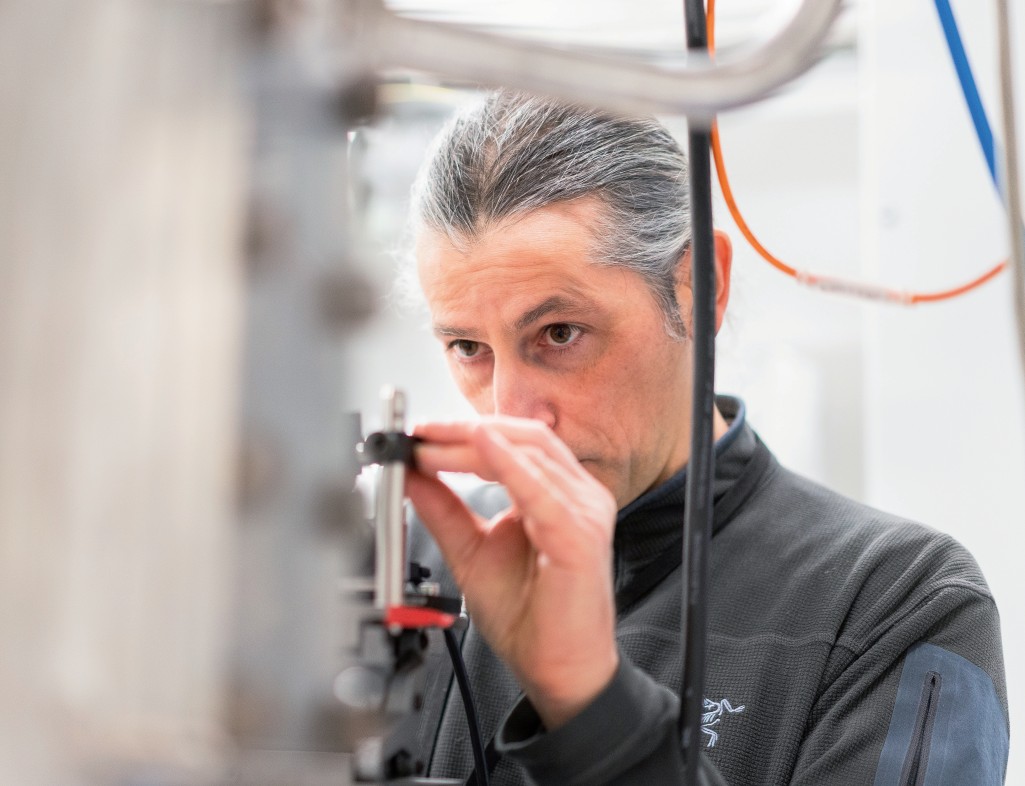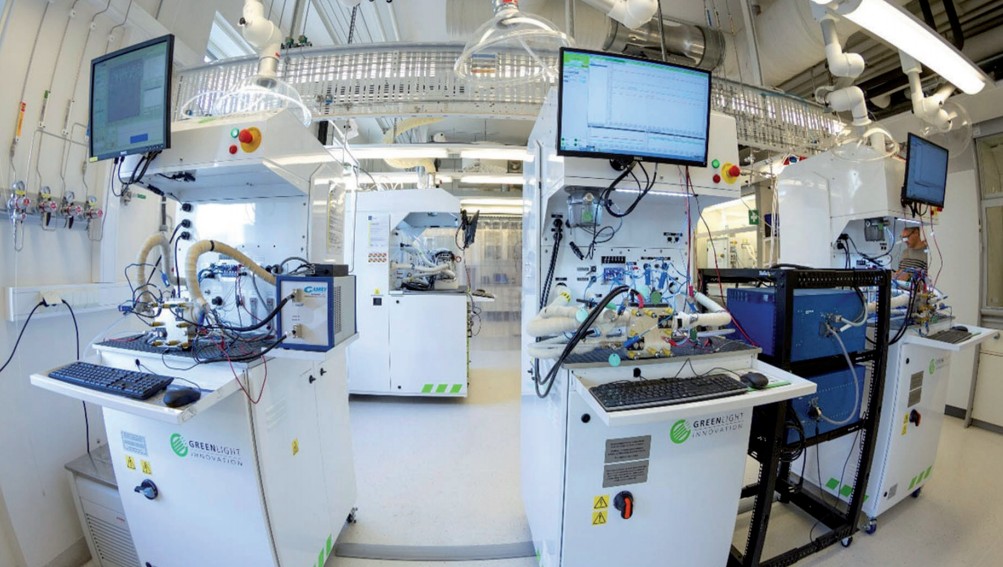
Authors: Stefania Gardarsdottir, Kyrre Sundseth
Many SINTEF researchers are focused on the development of Hydrogen as an energy carrier, and as a useful element in industrial processes for our future low-carbon society.
As a light yet energy-dense gas that can be made and stored with no direct CO2 emissions, Hydrogen has the potential to transform hard to decarbonise industries and transportation. Hydrogen also has an important role to play for future energy systems services as renewable energy production increases.
But we know that outside of the scientific community, Hydrogen isn’t well understood. You may have heard of Hydrogen and fuel cells, but why is hydrogen so important for the future of our planet? Let’s take a look at some of the most common questions we receive in Norway and beyond, and how SINTEF is involved in shaping our Hydrogen future.

What is Hydrogen and how is it used?
As a constituent part of water, Hydrogen is critical for all life on earth. But we have learned to harness the qualities of Hydrogen for many other uses. It is used to make ammonia for fertilisers and is an important ‘ingredient’ in making many types of commodities.
Because of its energy density, Hydrogen has great potential as a for later use in sectors as diverse as industry, energy, transportation, aviation, construction, and commercial- and domestic buildings. In countries with natural gas pipe systems, Hydrogen can replace natural gas for heating and stoves. It is also being used as a rocket fuel. NASA uses fuel cells in space!
Is Hydrogen safe?
Hydrogen is an energy-rich gas but it is not more or less dangerous than other fuels. However, it behaves in a different way than petroleum or the energy in a battery pack, for example, so it is important to work within the bounds of its characteristics.
Unlike other fuels, Hydrogen is not toxic. In the event of a leak, Hydrogen’s lightness means it is relatively quick to disperse. Hydrogen is flammable, but its characteristics and behaviour are well understood.
It is well known that H atoms may make metals brittle, so called hydrogen embrittlement. Therefore, materials that are exposed to hydrogen gas should always be carefully selected to ensure sufficient resistance towards this phenomenon.
Is Hydrogen eco-friendly?
Hydrogen emits no harmful CO2 emissions when consumed in a fuel cell or in a turbine. However, to assess the environmental credentials of Hydrogen, we must look at its source. The production of Hydrogen can be done in many ways, each with varying impact on the environment.
To help understand the source, hydrogen is often labelled with different colours.
How is Hydrogen made?
Hydrogen is a naturally occurring element, but we need to extract it for it to become useful as an energy carrier or in industry. Hydrogen can be extracted from fossil fuels, biomass or water. Known as water electrolysis, splitting Hydrogen from water using electricity has been done in Norway for decades.

Today, approximately 95% of hydrogen is produced from fossil fuels, being the main contributor. In Norway, there is large potential to produce clean Hydrogen from natural gas with carbon capture and storage technology to remove the emissions.
Producing Hydrogen from renewable energy such as surplus wind power is a smart, efficient way to capture energy that would otherwise be lost.
What are the different colours of Hydrogen?
Because hydrogen is often defined by its production process, we use colours to quickly identify the different sources. It is important to say that the hydrogen itself is the same – the colour is just a label!
Gray Hydrogen is the predominant method of production today. It is made from fossil sources. Blue Hydrogen is also made from fossil sources, but with one key difference. The carbon emissions are captured and stored through CCS technologies. Green Hydrogen is made from renewable sources through electrolysis.
Together, both green and blue will play an important role in our Hydrogen future.
What is the status of Hydrogen in Norway?
With decades of experience in both fossil-source energy (oil and gas) and renewable energy, Norway is a true energy nation. The government is now considering the role of Hydrogen for the future. Norway wants to achieve net-zero greenhouse gas emissions by 2050. To achieve this, many sectors must be decarbonised, and Hydrogen has a key role to play in that activity.
In 2020, the Norwegian government released the Norwegian Hydrogen strategy, which highlighted the potential of Hydrogen from both a domestic and export market perspective, the importance of both blue and green hydrogen and the unique position that Norwegian industry could take in a growing market.
A Norwegian Hydrogen roadmap is now under development with the Norwegian government, which will set a more concrete plan to achieve the Hydrogen strategy.
What is the potential for Hydrogen in Norway?
In the future, Norway can produce blue Hydrogen and ammonia from fossil fuels with the captured CO2 emissions stored in CO2 storage facilities deep below the ocean floor. Norway’s renewable energy production will have diversified with hydropower, solar power, offshore wind and potentially wave power all contributing to the sustainable, stable production of green Hydrogen.

There is undoubted potential for Hydrogen demand in many Norwegian industries, especially those that are hard to decarbonise today with other measures such as electrification and batteries. Hydrogen can be used to power cars, heavy transport such as land-based trucks, and maritime transport including passenger and cargo vessels. Norway is a world-leader in maritime transport and technology solutions in the maritime sector so there is significant export potential for new hydrogen- and ammonia technologies in this area. Hydrogen is also a key enabler for the decarbonisation of many process industries.
There is also likely to be significant demand for Hydrogen and related technologies from export markets, especially the EU.
What is the Hydrogen relationship between Norway and the EU?
Hydrogen has a central role to play in the EU’s green transition to climate-neutrality. In fact, the EU hydrogen strategy states a Hydrogen production from renewables goal of 6GW hydrogen by 2024 and 40GW by 2030.
If Norway is to remain a world-leading energy nation, retaining and building upon this close cooperation with Europe during the years to come is essential. While creating a domestic market and infrastructure for Hydrogen is step one, preparing the production and infrastructure for substantial export to Europe should not be far behind. If successful, job and value creation will be substantial, considering both domestic use and export of Hydrogen energy and technology solutions.
That’s one reason the Longship carbon capture and storage project is so important. Longship is the Norwegian government’s commitment to the full-scale implementation of carbon capture, transport and storage (CCS) technologies. The ability to capture and store CO2 at scale is an essential enabler to produce blue Hydrogen in Norway, which can be used to fast-track the development of an export infrastructure.
How do we get from today to the Hydrogen future?
Researching new and improved technologies is only one step in the creation of our Hydrogen future. While improvements are needed, we already know how to produce hydrogen in an environmentally friendly way.
What is truly needed to drive the change is Hydrogen demand. Creating market demand goes beyond the scope of technology R&D and into finance and politics. Companies and societies need incentives to change their entire infrastructure to use clean Hydrogen, and the same is true for public transport infrastructure.
Hydrogen offers great value if integrated into society-at-large, but the use of Hydrogen at a small scale is cost-prohibitive for most industries. We need Hydrogen hubs to share costs and risks across sectors. This requires a roadmap at both national and European level to move Hydrogen demand from the niche markets of today to widespread demand.
How do we develop a Hydrogen market in Norway?
What we can apply to Hydrogen development in transportation, marine and other industries is that it must become much more expensive for companies to emit greenhouse gases in order to give a universal inventive to use other technologies.

This can be achieved through taxes and duties, but also through other means. For example, Norway’s relatively large public sector could be utilised to require that suppliers use greener methods of production and delivery of solutions, such as Hydrogen. Developing a Hydrogen infrastructure on a national scale will help drive down costs, removing some of the uncertainties around choosing Hydrogen.
Finally, risk sharing between stakeholders can increase the rate of success when establishing large projects such as new infrastructure. For example, Norway’s Longship project is a public-private partnership. Such co-funding spreads risk and ensures that goals are aligned across industries and between the public and private sectors.
Why is R&D so important for Hydrogen?
Norway’s long experience in natural gas processing and renewable energy can be pivoted into Hydrogen-based solutions. Research platforms and collaboration with industry are necessary to build the top-notch competence and the business opportunities the country needs to become a world-leader in Hydrogen solutions.
But perhaps the most important reason for R&D investment in Hydrogen is to stimulate the increased use in multiple sectors. Upscaling Hydrogen like this is what gives the biggest cost reductions, making Hydrogen more attractive for other applications.
What Hydrogen research does SINTEF do?
Many teams within SINTEF have worked on different disciplines within Hydrogen research for a long period of time. There is a large spectrum of technologies and different value chains that are relevant for Hydrogen R&D, so SINTEF’s multi-disciplinary, multi-institute approach gives us a real advantage.
The focus of research has expanded over time from basic science to more applied science involving industry partnerships and demonstration projects. SINTEF researchers have been involved in the creation of spin-off companies and looking at Hydrogen as part of a wider topic such as the electrification of the Norwegian Continental Shelf in the Low Emission Centre.
End-use research focuses on for example fuel cells specifically for the transportation sector and offshore. Combustion researchers are also working on power generation for offshore platforms, and the combustion of Hydrogen and Ammonia in large engines. For many years SINTEF researchers have been part of the Deep Purple project developing an offshore wind energy system that could deliver green Hydrogen to more than 12 million Europeans in just a few years.
The EU-funded demonstration project REFHYNE – Clean Refinery Hydrogen for Europe is developing what will be one of the largest PEM electrolysers in the world.
There are 9000 km of subsea pipelines for transport of natural gas in the North Sea. This vast infrastructure is developed relying on close research collaboration between SINTEF and Norwegian industry over a period of 30 years. In the RCN and industry funded HyLINE project SINTEF now investigates the possibility of applying such pipelines for transport of pure hydrogen gas.
Finally, our researchers are spending more time on work to understand the role Hydrogen can play as an integral part of the energy system, especially investigating the interaction with other energy carriers such as electricity and heat. Examples of this include the CleanExport project and the Hydrogen for Europe initiative, while sectorial integration will be an important focus area in the future.
Authors: Kyrre Sundseth, Stefania Gardarsdottir

Pingback: Hydrogen4EU: A 6 minute snapshot of the study - #SINTEFblog
Hallo Kyrre og Stefania:
Rart at dere ikke nevner hvor mye naturgass eller fornybar kraft som kreves for å produsere de mange tusen tonn hydrogen som dere mener EU vil etterspørre. H2 er etter mitt skjønn en energikannibal og prosessen etterlater et enormt energitap. For å produsere 3300 TWh flytende hydrogen (LHG) med en brennverdi på 33 kWh per kilo, har vi trolig et energitap på 2300 TWh og står igjen med ca 1000 TWh. Og hvor mye energi går med til å transportere, trkke ned og lagre karbonet som skal dyttes ned i undergrunnen?
Dere bør være mer åpne om disse problemstillingene. Har dere regnet på energitapet ved å omdanne naturgass og vannkraft til H2?
Mvh. Steinar Arneson.
Pingback: Assumptions Matter When Assessing Blue & Green Hydrogen - #SINTEFblog